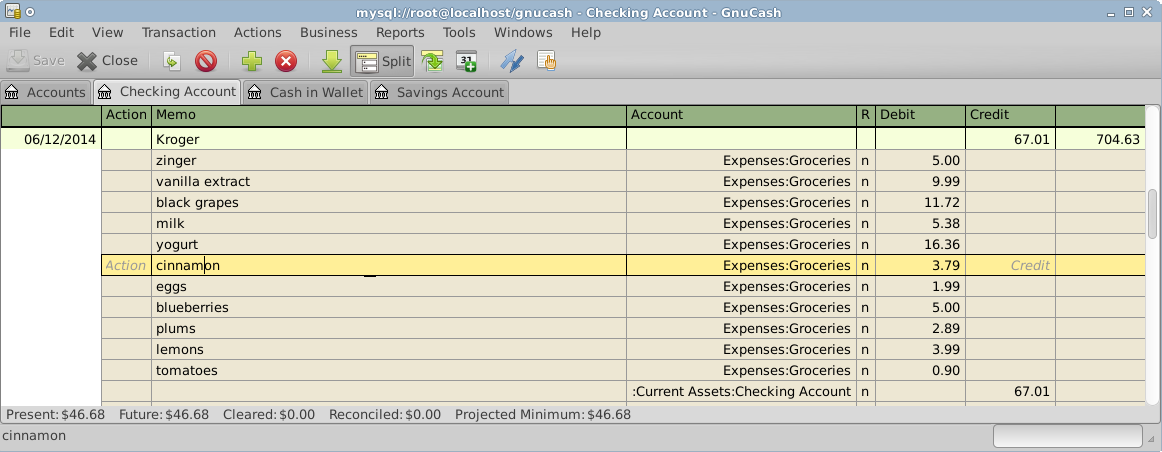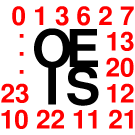In conventional accounting software such as GnuCash, a dupermarket receipt might be entered thus:

A particular line item in the receipt, say the cinnamon, is charged to a certain account, and that account is debited by the $3.79 price of the cinnamon. The credit side of the transaction is to the checking account; a portion of the $67.01 total. In thingcentric accounting as I propose it, the cinnamon purchase is not treated as a line item in a transaction covering a shopping cart full of merchandise, but a transaction that takes place when the cinnamon is added to the cart:
| epoch | thing | valuation | credit account | debit account |
|---|---|---|---|---|
| 1402597800 | Spice Islands® ground saigon cinnamon, 1.9 oz. glass jar | 3.79 | Liabilities:Accounts Payable:Kroger | Assets:Inventory:Food:Dry Goods:Seasonings |
The accounts payable credit will be cancelled at the cash register. The main difference is that we’re moving from debit and credit amounts to credit and debit accounts, respectively. Note that I put credit account on the left and debit account to the right. This is because I think of them as “from account” and “to account,” respectively. At the time we open the jar of cinnamon, we enter a transaction “from” inventory “to” an expenditure account appropriate to cinnamon.
In this system, inventory accounts in general are intended to be shared information. This is so we can do “internet of things” and hopefully do so without the middlecritter (i.e. do so cooperatively as contrasted with commercially). It should be able to answer questions like “where is the nearest X” that is in the possession of someone in the network of participants. I’m thinking network because I’ve been looking at ValueNetwork, the accounting platform for networks. This would be most straightforward if inventory is geotagged, but with that there is a privacy and security issue in that information about the presence of valuables in private homes is revealed. This brings us to the co-opted version of “sharing economy,” whose cheerleaders point out that transactions can take place between individuals, cutting out som(bunall) middlecritters. The middlecritter still standing is the “reputation metric provider,” an industry that almost overnight has produced at least one billion-dollar fortune. The reputation engine itself is decidedly closed-source, encumbered by as many copyrights, trademarks and patents as can be secured, and of course has all the information monetization schemes to be expected of commercial mobile apps in general. It is also becoming clear that information asymmetry is a key ingredient in the business model, in which criteria for exclusion and perhaps blacklisting are closely-guarded trade secrets. The key to a “disruption” in the form of the “sharing economy killer” that we all want is DIY reputation metrics in a way that is open source and open content. If our reputation engine can also offer respect for the privacy of individuals, I guess that would be the icing on the cake.
One approach might be to conceal actual spatial coordinates of a particular inventory item, but allow queries of along the lines of: “Is there an X within Y km of location Z?” Such queries might trigger notifications to the custodians of inventory found by the query; possibly initiating a sequence of messages resulting in the transfer of the goods. Another approach might be to forgo privacy altogether and shore up security through equiveillance. Surveillance cameras that are webcams; one in my pantry seem less privacy-invasive than one in my bathroom. Considerably more importantly, a camera under my auspices seems less privacy-invasive than one under police auspices, landlard auspices, etc. Also, access by the general public to information about my pantry seems less invasive than use of the same information by analytics providers who would use the information strategically, say to deduce or infer my internal price point for certain products.
If we set this up so that inventory accounts are property of the network, then purchases of goods by individuals constitute contribution of dollar-denominated value to the network. Consumption of goods (transfer out of inventory) is of course taking money from the network. There should be a way in which the question of whether someone is putting at least as much value into the network as they are taking out of it that is independent of where the acts of giving and receiving take place, and independent of which inventory custodians are dispensing the goods.
At this point what we have is an actually-sharing-economy that covers distribution of goods created in the actually-existing economy. Bringing the thingcentric accounting to household or cooperative production will of course be in most cases illegal and is where “agorism” comes in, and perhaps Bitcoin, as the authorities will demand not only taxes but licenses. The black-market nature of agorism definitely competes with the goal of extreme transparency. Extreme internal (but only internal) transparency would mean joining rather than beating the black-box “sharing” economy of Über, AirBnB, ad nauseam. The established-so-far simulacrum of sharing economy is heavily “disruptive” to licensing bureaucracy but minimally if at all disruptive to other forms of rent-seeking, such as intellectual property. An even bigger challenge at this point is keeping things anagoristic (non-market oriented). What goes into the “valuation” column once labor inputs are in play? Do people self-valuate? Letting the market decide somewhat defeats the purpose (at least one of them). The most important thing to accomplish is to establish such an act of creation as a process or graph node in an Angel Economy, or perhaps recipes in a ValueNetwork implementation. Eventually we want to have not only an inventory of things in possession of the network, but a catalog of things the network is known to be capable of producing.

Leave a Reply